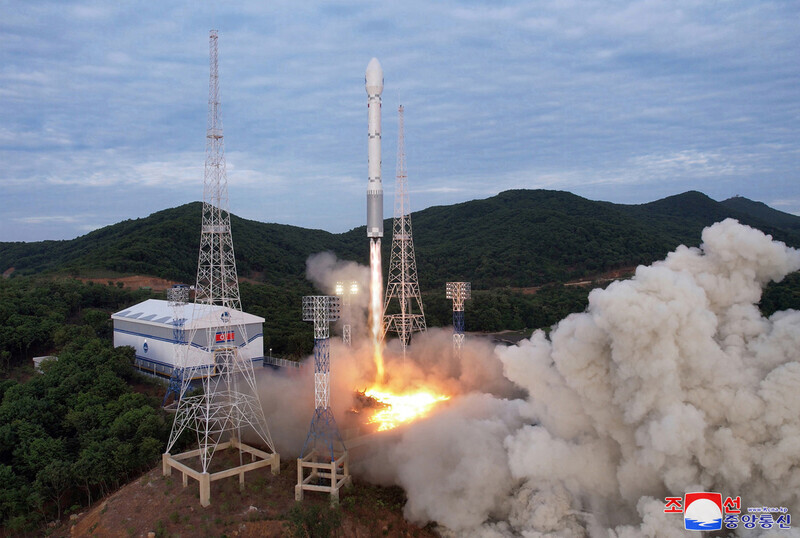hankyoreh
Links to other country sites 다른 나라 사이트 링크
N. Korea confirms second attempt to launch military spy satellite failed

North Korea officially announced Thursday that it had attempted another launch of a military reconnaissance satellite early that morning, but that the launch failed due to an “error in the emergency blasting system.”
This comes 85 days after a first launch attempt failed on May 31. The South Korean presidential office convened a meeting of its National Security Council standing committee to discuss response measures.
In a report published at 6:15 am on Thursday, the Korean Central News Agency said, “The National Aerospace Development Administration (NADA) of the DPRK conducted the second launch of reconnaissance satellite Malligyong-1 aboard the new-type carrier rocket Chollima-1 at the Sohae Satellite Launching Ground in Cholsan County of North Phyongan Province.”
“The flights of the first and second stages of the rocket were normal, but the launch failed due to an error in the emergency blasting system during the third-stage flight,” the report continued.
“Explaining that the cause of the relevant accident is not a big problem in aspect of the reliability of cascade engines and the system, the NADA expressed the stand that it would conduct the third reconnaissance satellite launch in October after thoroughly probing the reason and taking measures,” it said.
In response, the South Korean Joint Chiefs of Staff said, “At around 0350 hours this morning, the South Korean military detected a ‘North Korea-claimed space launch vehicle’ that was launched toward the south from the area of the Tongchang village in North Pyongan Province, North Korea, and passed through international airspace to the west of Ieo Island.”
“Having detected it immediately upon launch, [the South Korean military] continued tracking and monitoring it, and it is determined to have failed,” the Joint Chiefs added. “This launch of a purported space launch vehicle by the North was a clear violation of UN Security Council resolutions that prohibit any and all launches that utilize ballistic missile technology.”
The presidential office convened a National Security Council standing committee meeting presided over by Cho Tae-yong, the presidential office national security adviser. The meeting was reportedly attended by the minister of defense and other minister-level chiefs of related agencies.
North Korea’s latest failure to launch a military spy satellite comes 85 days after their first attempt went awry. On May 31, the North had used the space launch vehicle Chollima-1 to send its satellite, the Malligyong-1, into orbit, but a second-stage engine ignition failure caused the rocket to fall into the waters some 200 kilometers west of Eocheong Island on the South’s western coast.
During a plenary meeting of the Workers’ Party of Korea Central Committee in mid-June, leader Kim Jong-un called the botched satellite launch a “most serious” failure and demonstrated Pyongyang’s intent to successfully launch a satellite before long.
In regard to this, South Korea’s National Intelligence Service told the National Assembly on Aug. 17 that North Korea has been “concertedly carrying out engine combustion tests since late July to verify the reliability of the launch vehicle.”
Days later, on Aug. 22, North Korea alerted Japan that it would be launching a satellite between Aug. 24 and Aug. 31.
By Shin Hyeong-cheol, staff reporter
Please direct questions or comments to [english@hani.co.kr]

Editorial・opinion
![[Column] Tariffs on China: Trump was dumb, Biden dumber [Column] Tariffs on China: Trump was dumb, Biden dumber](https://flexible.img.hani.co.kr/flexible/normal/500/300/imgdb/original/2024/0520/191716191153918.jpg) [Column] Tariffs on China: Trump was dumb, Biden dumber
[Column] Tariffs on China: Trump was dumb, Biden dumber![[Column] What if Seoul took reunification by force off the table? [Column] What if Seoul took reunification by force off the table?](https://flexible.img.hani.co.kr/flexible/normal/500/300/imgdb/original/2024/0520/3017161928630494.jpg) [Column] What if Seoul took reunification by force off the table?
[Column] What if Seoul took reunification by force off the table?- [Editorial] Intensifying US-China rivalry means Seoul must address uncertainty with Beijing sooner than later
- [Column] When ‘fairness’ means hate and violence
- [Editorial] Yoon must stop abusing authority to shield himself from investigation
- [Column] US troop withdrawal from Korea could be the Acheson Line all over
- [Column] How to win back readers who’ve turned to YouTube for news
- [Column] Welcome to the president’s pity party
- [Editorial] Korea must respond firmly to Japan’s attempt to usurp Line
- [Editorial] Transfers of prosecutors investigating Korea’s first lady send chilling message
Most viewed articles
- 1Xi, Putin ‘oppose acts of military intimidation’ against N. Korea by US in joint statement
- 2Kim Jong-un wanted to meet with residents of shelled Yeonpyeong Island in South, Moon recalls in mem
- 3To weigh costs and benefits, Korea must stop treating US troop presence as a sacred cow
- 4[Column] Tariffs on China: Trump was dumb, Biden dumber
- 5[Column] What if Seoul took reunification by force off the table?
- 6[Editorial] Transfers of prosecutors investigating Korea’s first lady send chilling message
- 7Berlin mayor hints at tearing down ‘comfort women’ memorial in city
- 8KEPCO undergoes repairs for cracks in nuclear reactor containment buildings in UAE
- 9[Photo] Twitter now lets users decide who can reply to their tweets
- 10Smartphones have been shown to hurt brain development — can Korean kids kick the habit?